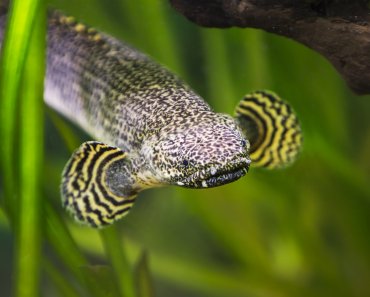Saltwater angelfish are some of the most recognizable fish species in the aquarium-keeping hobby. Angels are colorful, big, and picturesque against a coral reef backdrop.
But did you know that angelfish aren’t reef-safe and can’t be kept with corals? These fish require a lot of swimming space and should be introduced with caution to the aquarium.
Keep reading to find out everything you need to know about saltwater angelfish and which species you can add to your aquarium!
About angelfish
Angelfish range in shape and size. Some species are fit for smaller tanks, while larger saltwater angelfish need massive industrial-sized aquarium displays.
Name and natural habitat
Saltwater angelfish belong to the Pomacanthidae family and should not be confused with freshwater cichlids of the Pterophyllum genus that go by the same name.
There are nearly 100 different saltwater angelfish species commonly found around shallow tropical reefs worldwide. They mostly live solitary lives feeding on algae, corals, and other animals living among the reef; some species may form harems.
Are saltwater angelfish aggressive?
These fish often have bold personalities and can become very territorial, especially during spawning periods. Active during the day, angelfish retreat to the shadows of the rocks at night.
They can be aggressive in captivity, especially if placed in an inadequate tank or introduced before other species. Of course, the level of aggression will depend on the species and the individual fish.
Some species, like the Emperor angelfish (Pomacanthus imperator), need to be added last to the aquarium to prevent problems with tank mates. For this reason, make sure to research each species thoroughly before adding them to your tank.
Appearance
Angelfish have a recognizable body shape. They have laterally compressed bodies with an oval shape. Their fins are often flush with their bodies, with colors and patterns carrying across to the fin; they are usually ornate and have streamers and colorful margins.
Angelfish can grow anywhere from 3 inches (7.6 cm) to 2 feet (70.0 cm), with colors and patterns of reds, oranges, yellows, greens, purples, blues, blacks, whites, and neutral tones.
Historical problems
There is some controversy about keeping angelfish in the home aquarium setting, namely around keeping wild-caught individuals, because cyanide-fishing practices are still prevalent in the areas where these fish are collected.
This method of catching fish involves squirting cyanide at fish on the reef; some fish die while others are stunned long enough to collect them. Not only does this cause long-term health problems for the fish, but large sections of life on the reef are killed upon direct contact with the poison.
Afterward, this poison is nearly untraceable unless specific tests are run. But before suspicions start to arise, the fish has already been distributed to retailers and sold to consumers.
The fish often dies in quarantine shortly after being purchased if it is lucky enough to make it that long. Because there are no telltale signs of cyanide poisoning, these cases are often brushed off as weak fish.
You should also note that some angelfish live at considerable depths in the ocean. Collectors rarely worry about properly acclimating the fish on its way up through the pressure gradient of the sea. As with other animals, this sudden change in pressure can be fatal.
So how can you ensure that you’re not supporting cyanide fishing or other poor fishing practices? The best way to obtain a healthy fish is to buy captive-bred individuals. This will help prevent unwanted diseases and illnesses from entering the aquarium.
Differences between angelfish species
As mentioned before, there are many different kinds of angelfish in the Pomacanthidae family.
Before reviewing the specific species of marine angelfish available, here is a general overview of the most common genera you’ll see.
Centropyge
These fish are considered dwarf varieties and come from the Atlantic, Pacific, and Indian Oceans. These fish live in harems in the wild with one dominant male and multiple females.
Some species in this genus include the Coral Beauty (Centropyge bispinosa) and the Flameback angelfish (Centropyge acanthops).
Pomacanthus
These angelfish are much larger and include giants like the Emperor angelfish (Pomacanthus imperator). These fish are found in almost all tropical waters of the world but are prevalent in the Indo-Pacific and Pacific Oceans.
Members of Pomacanthus undergo physical transformations from the juvenile to the adult stage; this change can be so extreme that juvenile fish might not be recognizable as the same species.
Adult Pomacanthus spp. are prized for their vibrant colors and patterns.
Holacanthus
Holacanthus spp. are some of the most colorful fish on the reef. While these fish are popular in the aquarium hobby, they are also a favorite culinary dish in some cultures.
One of the most notable species from this genus is the Queen angelfish (Holacanthus ciliaris).
Common species of saltwater angelfish
Many species of angelfish, even some of the giants, have been brought into the aquarium-keeping world because of their beauty. However, just because you see an angelfish at the aquarium does not mean that species will work in your home display.
Here are some of the most common species of saltwater angelfish available and how to take care of them in your tank!
Flame angelfish (Centropyge loricula)
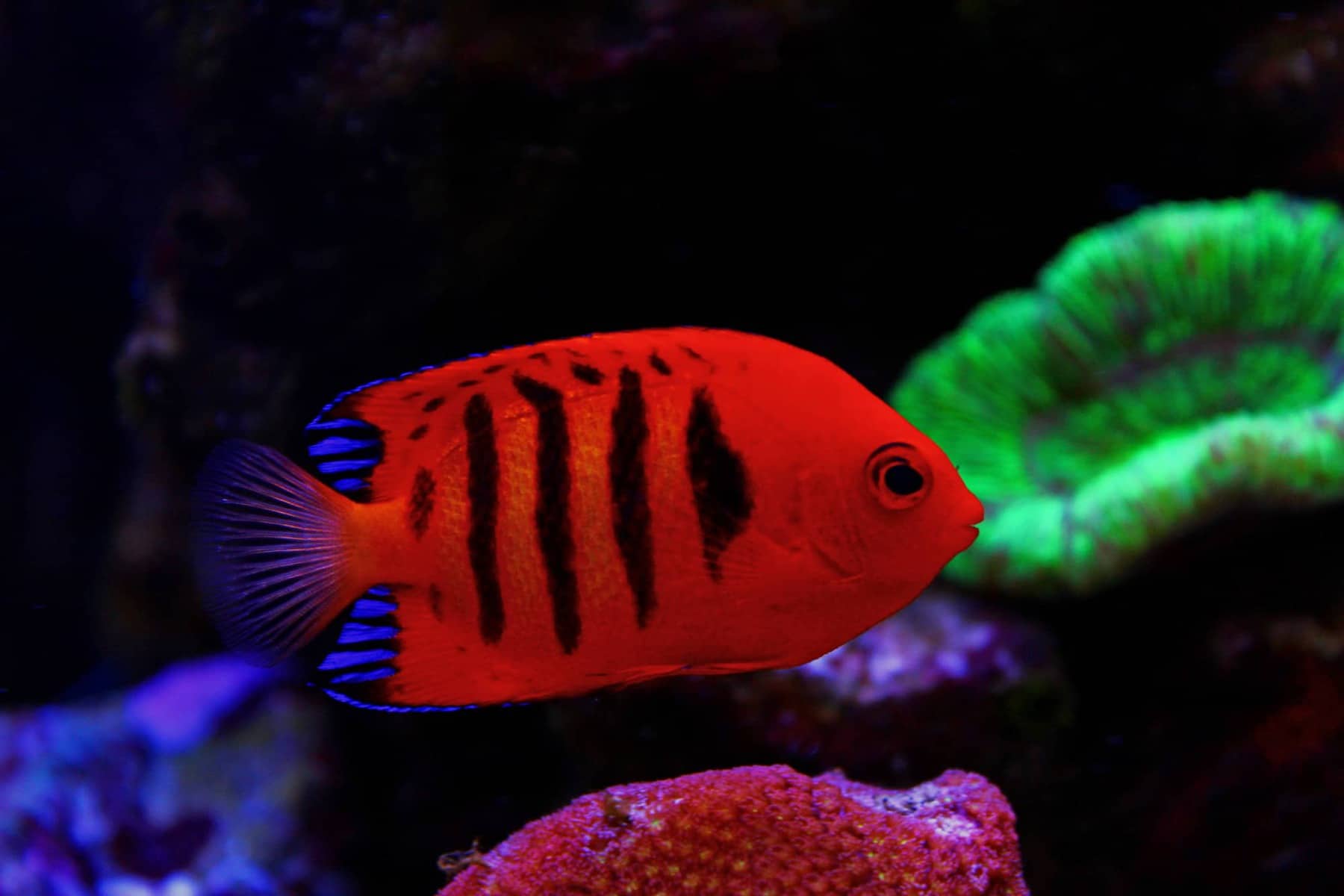
The most common angelfish in the average saltwater tank is the Flame angelfish. These dwarf angels are relatively small, and some hobbyists might not even know they’re angelfish!
Flame angels grow to an average size of 4-6 inches (10.2-15.2 cm) long when fully grown and are popular due to the intense red and yellow colorations that make this fish glow like a fire.
Though small, Flame angelfish are active swimmers and need a lot of space to explore and graze. The bare minimum tank size recommended for flame angels is 55 gallons (208.2 L), with longer tanks being much better than taller ones.
Some hobbyists have had luck keeping these fish with corals, but it is a safe bet that they will try to eat any corals within the tank. These fish can also be pretty aggressive towards other fish, so they’re best kept with other species with similar demeanors.
Coral beauty (Centropyge bispinosa)
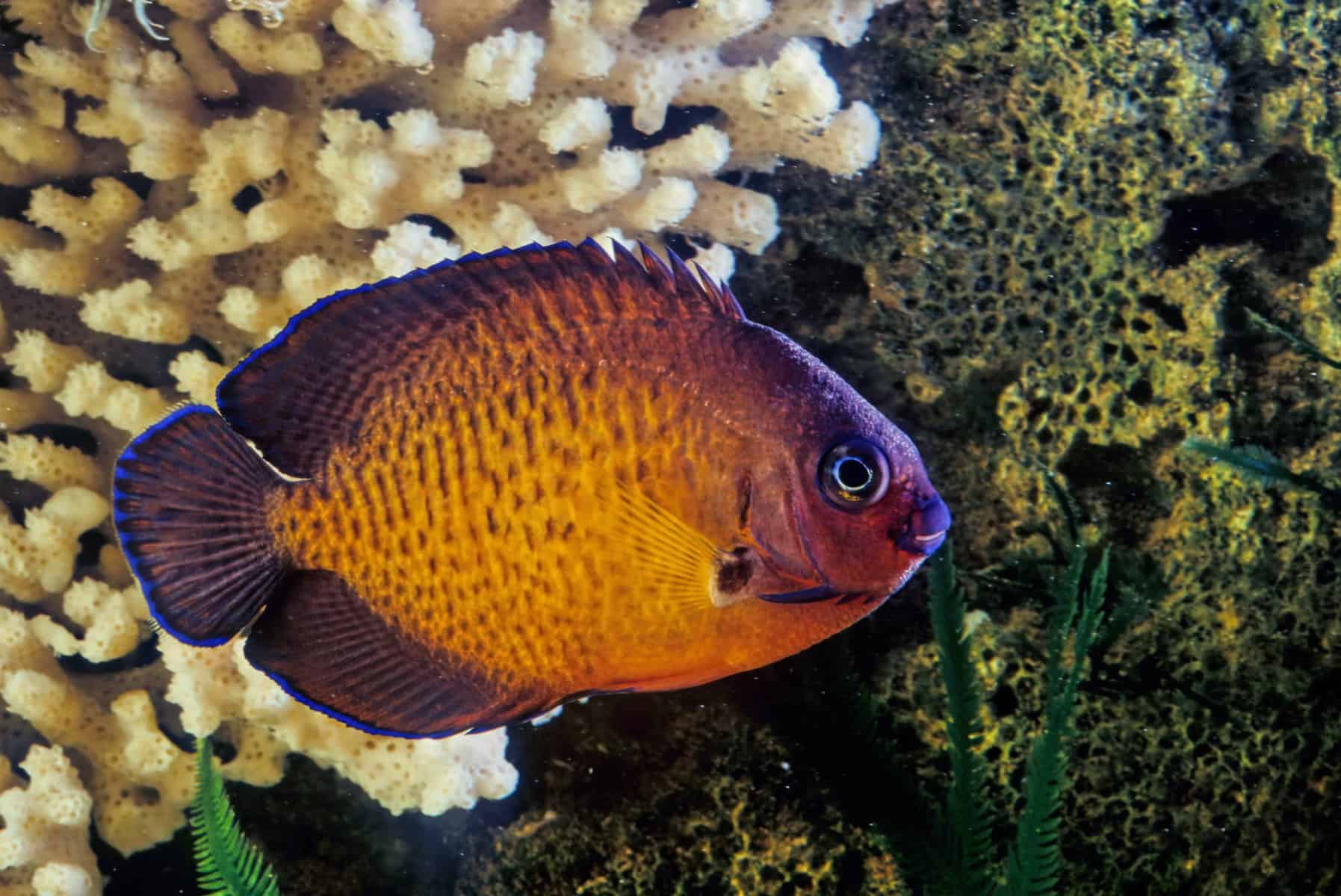
The Coral Beauty is the second most popular species of angelfish and often a dream to house together with flame angels. Though these two dwarf angels have similar needs, they can only be kept together in extremely large tanks.
Coral Beauties have beautiful shades of deep purples, yellows, and oranges and grow to about 4-6 inches (10.2-15.2 cm) long. They require a tank of at least 55 gallons (208.2 L) capacity with extensive rockwork for grazing and open space for active swimming.
Because the Coral Beauty looks the same as and compliments the colors of Flame angels, they’re often kept together by beginner hobbyists in inadequate tanks. The truth is that these fish can only be put together in large tanks, preferably 125 gallons (473.2 L) and up.
Like Flame angels, Coral Beauties can be just as aggressive and will pick at any corals in the tank. They need plenty of space to claim as their own in the aquarium.
Bicolor angelfish (Centropyge bicolor)
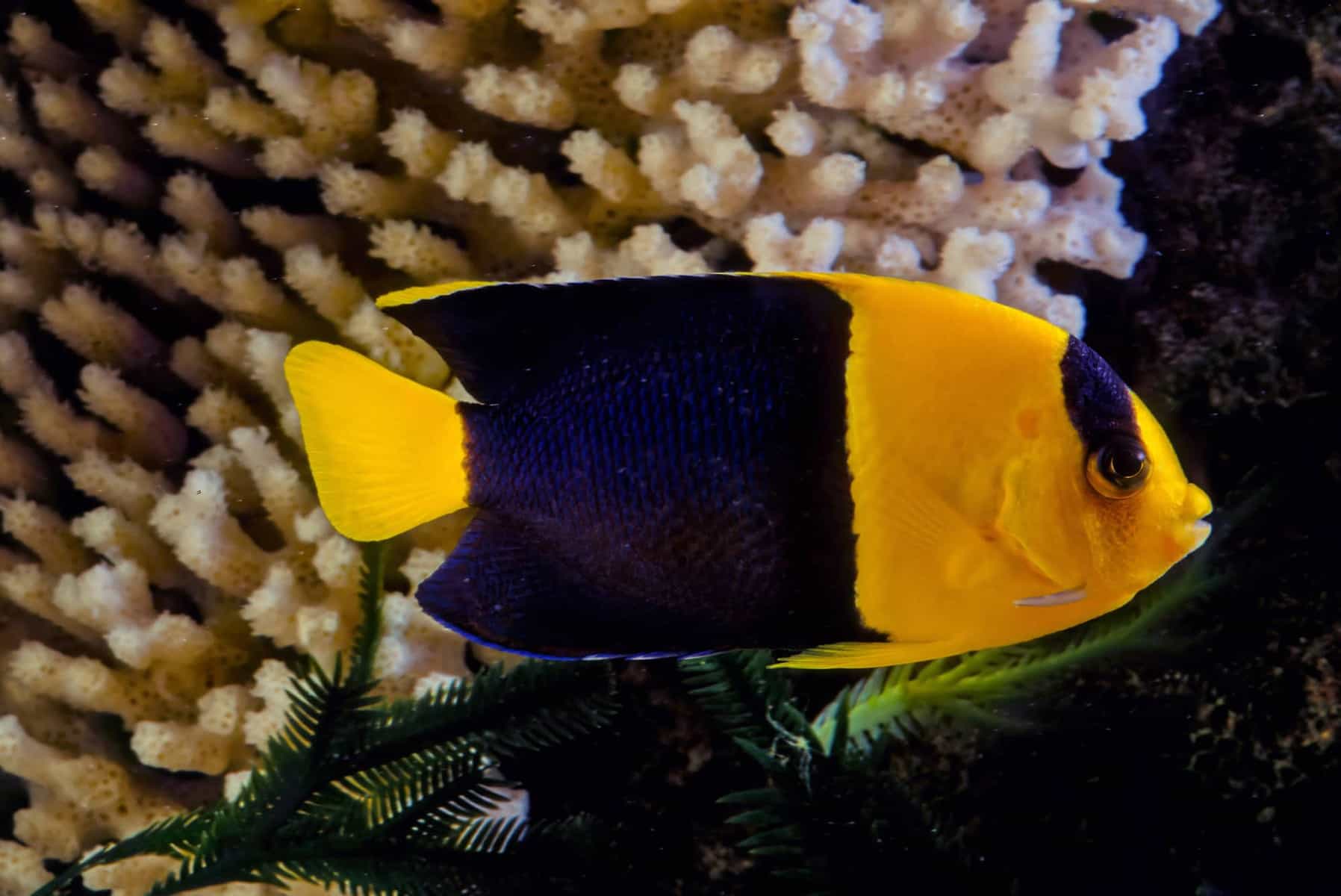
Bicolor angelfish aren’t as popular as the flame angel or coral beauty. These dwarf fish usually cost less, making them an attractive choice for beginner hobbyists.
However, just like the previous two angels, the Bicolor angel still needs all the care that goes along with any angel species.
These striking yellow and blue angelfish can grow to about 6 inches (15.2 cm) in length when mature and need a lot of space to swim. The bare minimum aquarium size is 55 gallons (208.2 L), with plenty of hiding places and small tank mate populations.
Most Bicolor angelfish will quickly devour any large polyp stony coral (LPS) available in the tank. While you might get lucky at first, there is always a chance that an angel will start eating corals overnight.
Pygmy angelfish (Centropyge argi)
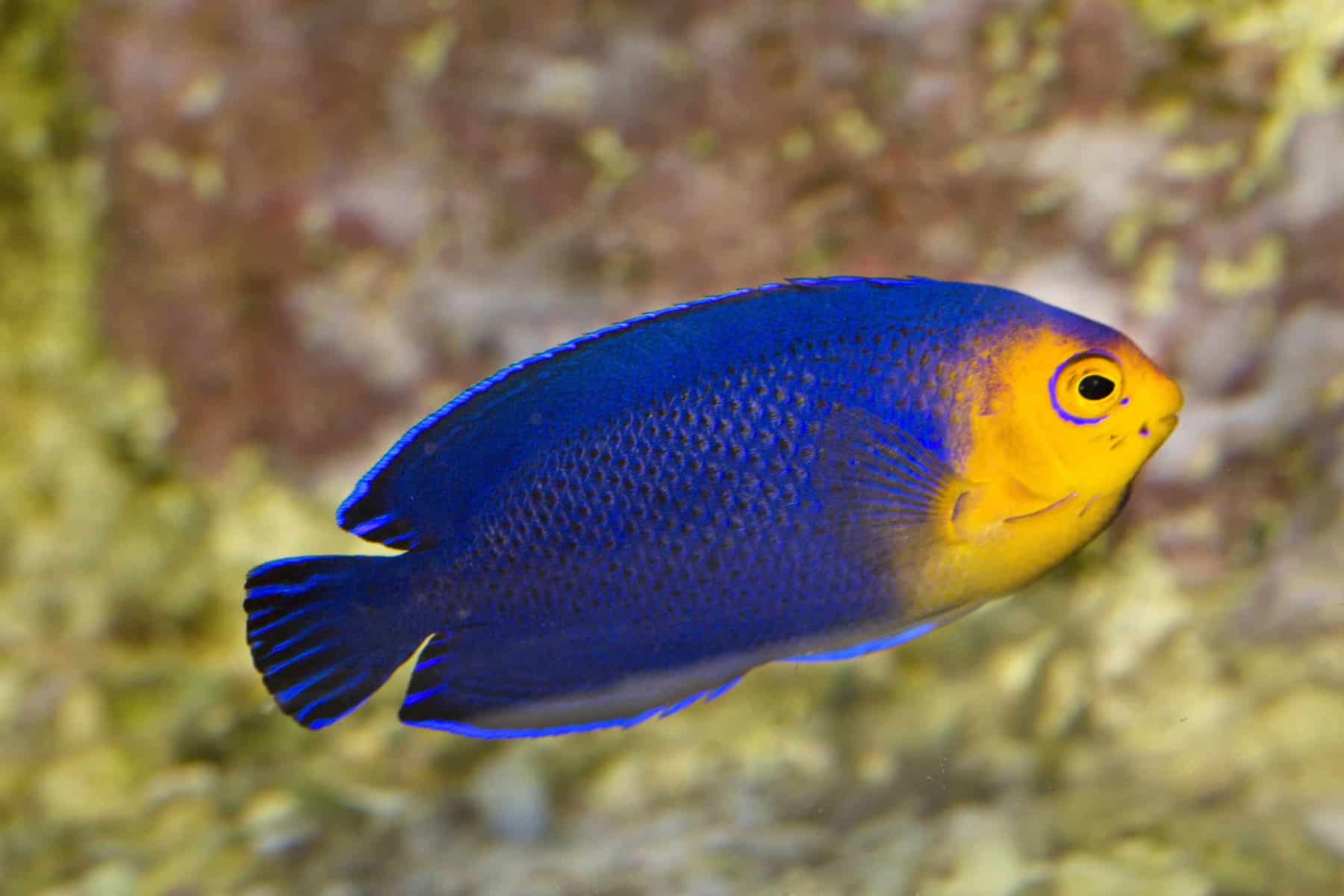
But what about angelfish for smaller tanks? There has to be something available, right?
If you plan on keeping a fish only with live rock (FOWLR) tank, then the Pygmy angelfish, commonly known as the Cherub angel, might be a good addition.
These fish bring similar coral-beauty-purples and a yellow face to the tank while staying under 3 inches (7.6 cm) in length. However, there is some debate about how small a tank is too small for these fish.
We recommend a tank of at least 40 gallons (151.4 L) with a bare minimum population. Though small, these fish are incredibly active and will get easily stressed out when conditions are cramped.
Pygmy angels can also be pretty aggressive, so we recommend only having one per tank, even in larger setups. They are not reef-friendly.
Flameback angelfish (Centropyge acanthops)
The Flameback angelfish is another popular pygmy angelfish that has very similar purple and yellow coloration to the Pygmy and Coral Beauty.
Adult angelfish are about 3 inches (7.6 cm) long, though they need space to swim. Forty gallons (151.4 L) is the minimum tank size recommended with very light stocking.
These fish are very close in appearance to the Brazilian Flameback angelfish (Centropyge aurantonotus). The only difference is that C. acanthops has a somewhat transparent tail fin while C. aurantonotus has a solid blue tail.
C. aurantonotus is also a little rarer in the aquarium hobby.
French angelfish (Pomacanthus paru)
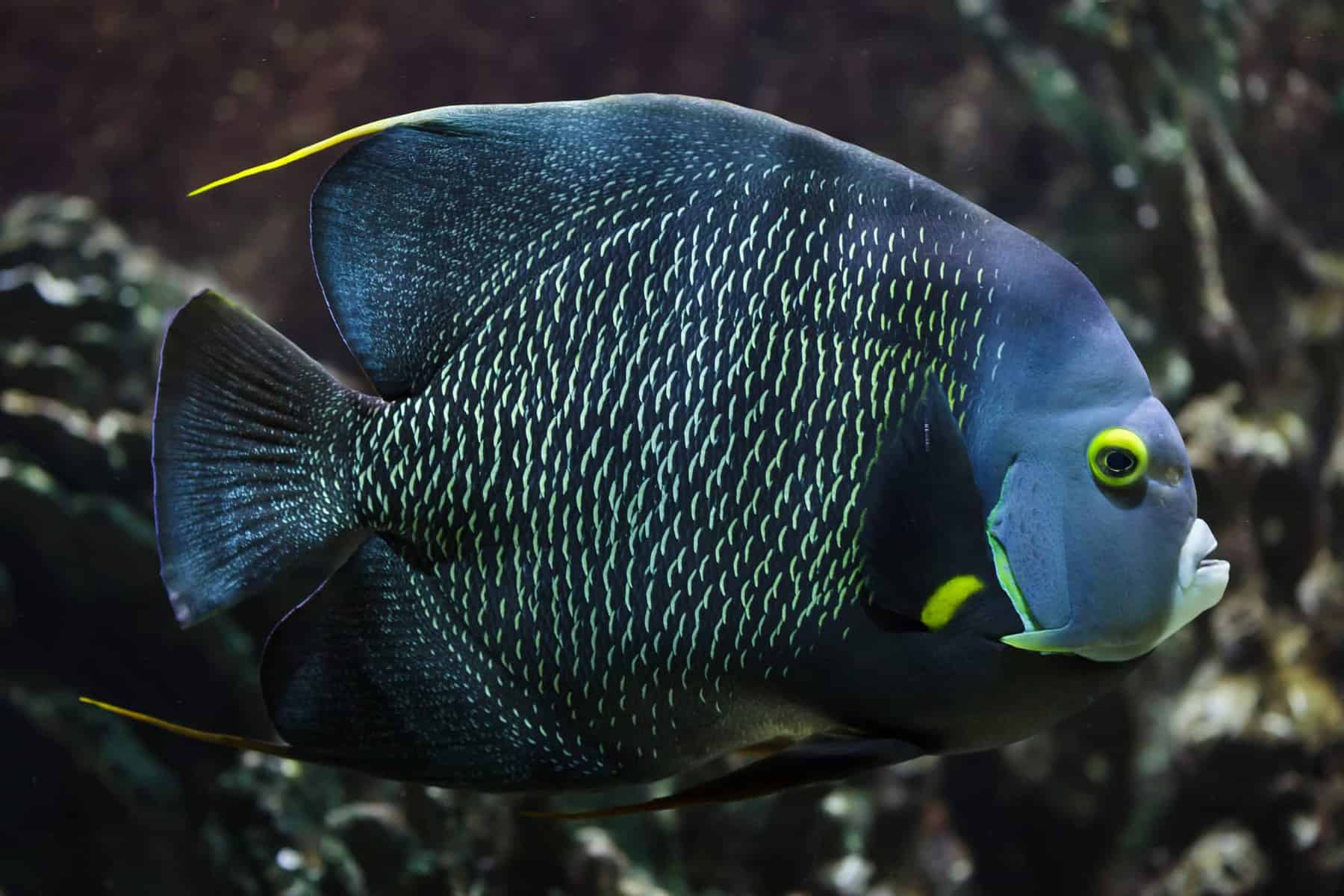
The French angelfish is beautiful with its black body and contrasting yellow speckles. Though beautiful, these Caribbean fish are not for the average hobbyist.
These larger fish can grow to 15 inches (38 cm) long when fully grown. As juveniles, they have alternating vertical black and yellow stripes, which eventually transform into their adult patterns over a couple of years.
For most of the day, they will graze on the rockwork, picking at whatever they can find to eat. These fish are not reef-safe and will probably try to eat any corals and fleshy invertebrates in the tank.
Because they are such active grazers and can grow to extreme sizes, a 200 gallon (757 L) aquarium is the bare minimum, with larger sizes allowing for more tank mates.
Blueface angelfish (Pomacanthus xanthometopon)

The Blueface angelfish, also known as the Yellowface angelfish, comes from the Indian and Pacific Oceans. These saltwater fish are some of the most beautiful angelfish, with a strong blue face with yellow and blue alternating speckles.
Blueface angelfish undergo a color transformation as they age into adults. Juveniles have blue, black, and white alternating stripes, which change into adult colors and patterns over a few years.
When fully grown, these fish can reach about 15 inches (38 cm). Like the other large species of angelfish, Blueface angels are not reef-safe fish and need large areas of rockwork to graze on algae and other foods.
These fish are sometimes confused with the Queen angelfish (Holacanthus ciliaris).
Emperor angelfish (Pomacanthus imperator)
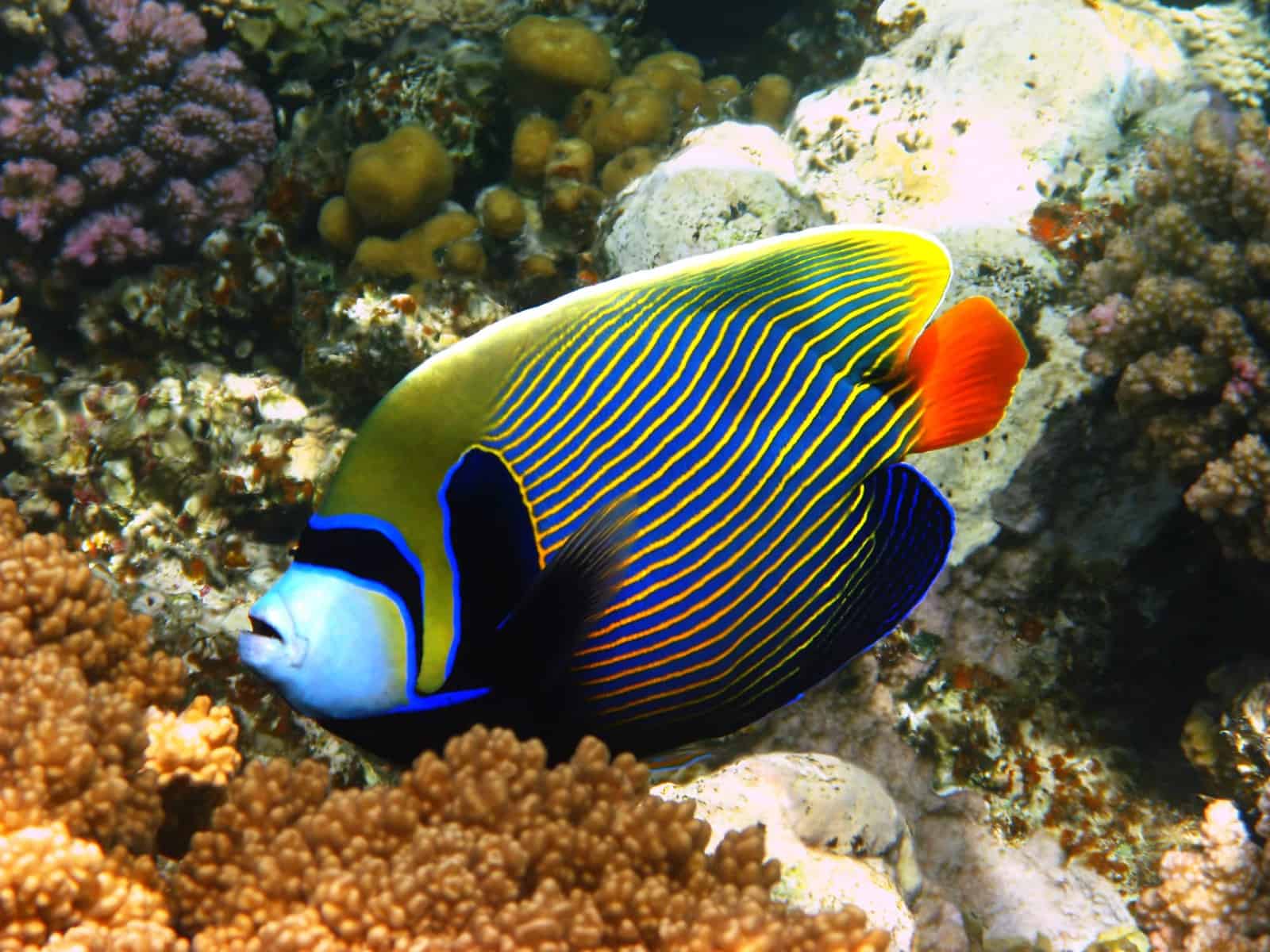
The Emperor angelfish, also known as the Imperator angelfish, is a show-stopping fish with high demands and a hefty price tag. They’re truly the rulers of the reef.
These impressive fish can grow over a foot long and max out at about 15 inches (38 cm). Emperor angels change colors as they mature. Juveniles start with alternating blue, black, and white rings. It isn’t until later that they morph into the beautiful white-faced giants with horizontal yellow and blue stripe patterning.
You should also note that this colorful angelfish’s behavior changes with age. As juveniles, they stick around the outskirts of coral reefs towards the open ocean. Eventually, they start forming territories and claiming areas of the rockwork as their own. This transition can take a couple of years.
In the aquarium, these fish are aggressive and not reef-safe. Some hobbyists have seen their emperors take over their tank hierarchy, while others claim they’re the calmest fish they’ve ever had.
To prevent possible aggression, it’s best to add this fish to the display last and avoid any tank mates that might be mistaken for another Emperor.
The minimum tank size needed to keep an adult fish is 200 gallons (757 L). This will allow for swimming space, grazing areas, and protection in a complex rockwork setup.
For a full care sheet on the Emperor angelfish, make sure to check out our article dedicated to them here.
Angelfish species to avoid
Just because you see an angelfish for sale at your local aquarium store does not mean that it belongs in a regular home aquarium.
Some imported species are incredibly difficult to care for in terms of diet, aggression, or spatial needs and should only be kept by experts or public aquariums.
Here are a few species of angelfish you should avoid no matter how beautiful you might think they’ll look in your aquarium:
- Multibar angelfish (Paracentropyge multifasciata) are very shy fish and incredibly picky eaters.
- Regal angelfish (Pygoplites diacanthus) do not acclimate well to tank settings and can be very difficult to feed. In general, they do not last long in captivity.
- Rock beauty angelfish (Holacanthus tricolor) rely heavily on grazing on rocks, corals, and sponges. Because of this, it is nearly impossible to keep up with their preferred diet, and the fish usually suffers as a result.
- Venustus angelfish (Centropyge venustus), also known as the Purple Masked angelfish, are very shy and naturally found hidden away in caves and crevices in the rockwork of coral reefs. As a result, they need to be acclimatized to brighter lights and given intricate rockwork. These fish also heavily rely on grazing, corals, and sponges for food.
- Banded angelfish (Holacanthus arcuatus/Apolemichthys arcuatus) are costly fish that are rare to come by. Due to their price and difficulty to find, they are not commonly kept. Like the other angels listed, Banded angelfish can be very difficult to feed.
- Queen angelfish (Holacanthus ciliaris) are some of the most breathtaking fish to live around coral reefs and in the aquarium setting. However, these fish are best left in their natural habitat or an industrial-sized tank. These largest angelfish can grow to 18 inches (45.7 cm) long and need an elaborate setup for open swimming and grazing.
Saltwater angelfish tank mates
Experts usually recommend building a saltwater aquarium around the most aggressive or largest species you plan to keep. By choosing a species of angelfish, you lose the ability to start a reef aquarium.
Luckily, most fish added to the reef aquarium can also be kept in a fish only with live rock (FOWLR) tank. But even though some hobbyists have had long-term luck keeping their angelfish with corals, it is not recommended unless you’re willing to lose a few corals along the way.
That said, the types of tank mates largely depend on the size of the tank. We should also note that you will still need to consider aggression.
Here are some possibilities based on the size of your aquarium:
<100 gallons (<378.5 L)
One hundred gallons will comfortably fit one of the previously mentioned dwarf species of angelfish. Some other options include:
- Damsels (including clownfish) – semi-aggressive
- Firefish – peaceful
- Wrasses – semi-aggressive
- Gobies – peaceful
- Blennies – peaceful
- Cardinals – peaceful
- Snowflake eel – semi-aggressive
Some hobbyists may include a small species of tang in this mix, but we think tangs should be saved for a larger aquarium if you are planning on keeping an angelfish as well.
100-200 gallons (378.5-757.1 L)
A 100-200 gallon tank can accommodate all the marine fish previously listed as well as:
- Tangs – semi-aggressive
- Pufferfish – aggressive
- Triggerfish – aggressive
- Lionfish – aggressive
- Moorish idols – semi-aggressive
- Boxfish/cowfish – semi-aggressive
- Filefish – semi-aggressive
- Butterfly fish – semi-aggressive
At this point, it may be possible to house a couple of angelfish together, with caution.
200+ gallons (757.1+ L)
While you might think you can add most types of fish to an aquarium this size, it depends entirely on the species of angelfish you plan on having. If choosing to go with a larger species, like the Emperor angelfish (Pomacanthus imperator), you will need to see how that fish interacts with the rest.
In addition to the previous species listed, here are some options for a 200+ gallon aquarium:
- Harlequin tusk – semi-aggressive
- Parrotfish – semi-aggressive
- Groupers – semi-aggressive
- Snappers – semi-aggressive
- Bannerfish – Peaceful
Also, consider keeping some fish, like tangs, in schools instead of keeping only singular individuals.
How many saltwater angelfish can I keep together?
Angelfish are beautiful, and hobbyists would fit them all into their tanks if they could. The sad reality is that these fish usually don’t do well when placed together in the same aquarium.
In general, Dwarf angelfish cannot be kept together even in very large systems. They look too similar, and territorial aggression arises. Some hobbyists suggest introducing multiple Dwarf angelfish together at the same time or using an acclimation box to diffuse aggression, but this isn’t a guaranteed method.
Otherwise, small angelfish can usually be kept with larger angelfish with no problems as long as they are different species. Large angelfish of the same species are almost guaranteed to fight and should never be placed together unless specialized for breeding.
As with other fish, it is best to add all the angelfish together at once or sequentially according to aggression levels.
Angelfish feeding
Luckily, most species of angelfish are not very picky eaters; if you’re going for more difficult species, try purchasing captive-bred fish as this will give a higher success rate with feedings.
Angelfish will pick at the rocks or graze on algae and other microfauna and microflora that might be growing there. Of course, this can include corals.
These saltwater fish can be fed a variety of frozen, freeze-dried, and live fish food. This includes bloodworms, brine shrimp, krill, and other pieces of fresh seafood, like pieces of fish and various mollusks. Angelfish will also appreciate algae snacks, like flakes, pellets, and seaweed sheets.
A high-quality marine fish pellet or flake should be the staple of the diet to reduce the cost of feedings while also providing your fish with the best care possible.
Angelfish breeding
Angelfish are challenging to breed. Not only do you need to have plenty of space to allow more than one angelfish to coexist, but the survival rates of offspring are also generally low.
Depending on the species of angelfish, at least double the recommended tank size should be given for mating and spawning purposes. The best way to encourage spawning is by keeping aquarium water quality up and feeding the fish high-quality foods.
Eggs are usually moved into a controlled setting where hobbyists regularly check development under microscopic viewing. Needless to say, angelfish breeding isn’t suggested for everyone.
Conclusion
Whether you’ve only ever kept freshwater angelfish or you have experience breeding some of the most challenging marine angelfish, there is a species for everyone.
These fish require much more care and consideration than other types of saltwater fish, so it’s important to thoroughly research and plan out your tank before impulsively adding one to your system. Otherwise, they can bring intense colors and patterns to a FOWLR aquarium.
If you have any questions about saltwater angelfish, freshwater angelfish, or have had experience keeping any of the species listed above, don’t hesitate to leave a comment below!


